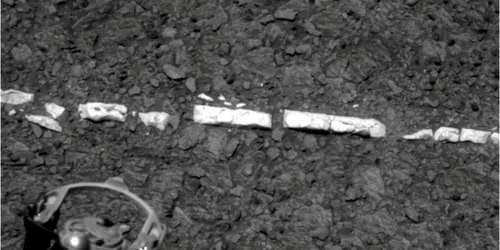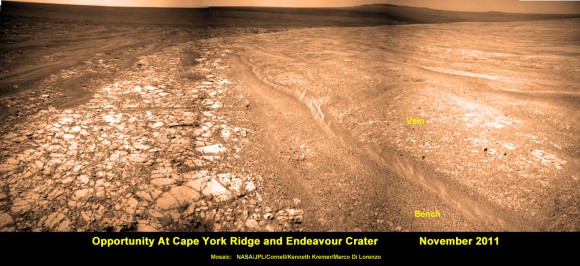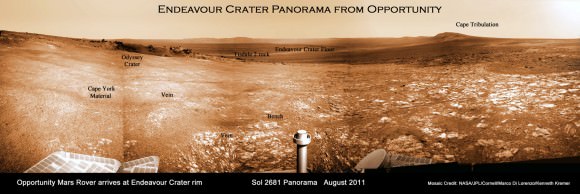[/caption]
NASA’s intrepid robogirl Opportunity is now swiftly scouting out locations at a Martian hill along gigantic Endeavour crater that would simultaneously proffer a goldmine of sun and science as her power level drops significantly in these waning days of Martian autumn ahead of the absolutely brutal and potentially deadly 6 month long Antarctic winter that’s fast approaching. Opportunity has just discovered a geologic vein possibly formed as a result of flowing water eons ago.
But, search time for a sunny exposure at the Martian hill known as Cape York is running out says the Mars rover team in new interviews with Universe Today. Recall that lack of power and utterly frigid temperatures killed her twin sister Spirit last winter.
“Martian winter in the southern hemisphere starts on March 29, 2012 or Sol 2908. But, Solar power levels already begin dropping dramatically months before Martian winter starts,” said Alfonso Herrera to Universe Today, Herrera is a Mars rover mission manager at NASA’s Jet Propulsion Laboratory in Pasadena, Calif.
“Orbital imagery indicates that the northern-most tip of Cape York might have north facing slopes which Opportunity will need in order to generate enough solar power to sustain her comfortably throughout the winter,” Herrera explained to me.
The team is very excited about the science implications of the vein detection.
“The importance of veins is that often they occur from the deposition of material that was dissolved and transported by hot water in cracks deep underground,” said Bruce Banerdt to Universe Today. Banerdt is the Project Scientist for the Mars rover mission at JPL.

Segments of Endeavour’s rim at Cape York and Cape Tribulation about 6 kilometers further south offers scientifically rich motherlodes of phyllosilicate clay minerals and other water bearing minerals that formed Billions of years ago on Mars and that could possibly point to habitats favorable for the genesis and support of Martian microbial life forms if they ever existed in the past or present.
Opportunity is currently traversing about the hilltops and slopes of Cape York where she recently made landfall after an epic three year trek across the plains of the Meridiani Planum region of Mars.
Initial reconnaissance around the southern tip and then climbing on top of the central ridge of Cape York have already yielded a bonanza of new science data at rock types never seen before on Mars, according to Steve Squyres, the Mars Rover Principal Investigator of Cornell University.
The rover is now driving north and back down around the base while searching for a “winter haven” with more potential for great science and a northerly inclined slope to more efficiently catch the sun’s rays.
“Opportunity is heading north to find the best winter site,” Ray Arvidson told Universe Today. Arvidson is the rover’s deputy principal investigator, of Washington University in St. Louis.
“We are more than halfway toward the northern part of Cape York where there are slopes steep enough to provide an energy-valid winter site and where science can take place. Now we are driving away from the predicted outcrops [of smectite clay minerals] on Cape York and onto the bench on the western side because we have run out of time to investigate these outcrops.”

However, the rover team was still hoping to catch a break for science opportunities along the way north and just chanced upon geologic veins potentially indicative of past flow of liquid water.
“The bench around the edge of Cape York looks like sedimentary rock that’s been cut and filled with veins of material possibly delivered by water,” says Arvidson.

Opportunity has just driven to a light toned vein at a spot dubbed “Homestake” and will spend a few sols (martian days) investigating with all the tools on the terminus of the robotic arm – including some Microscopic Imager (MI) images of the vein and placing the Alpha Particle X-ray Spectrometer (APXS) on top for overnight integrations.
“Opportunity will then continue traveling on the outboard side of Cape York (i.e. facing the plains),” Herrera told Universe Today.
“Plans are subject to change, but currently, Opportunity will travel to the north end of Cape York and stay there for the winter if suitable north facing slopes are found.”
“Our hope is that once a winter haven is identified, Opportunity will have enough power to make brief forays for science gathering in the vicinity of the winter haven,” Herrera informed me.


Opportunity rover is exploring around the base of Cape York hill at the bench and vein features which may hold clues to the ancient flow of liquid water here on Mars. Opportunity drives North (ahead) from here in search of a sunny winter haven. Mosaic Credit: NASA/JPL/Cornell/Kenneth Kremer/Marco Di Lorenzo
Opportunity’s power levels have dropped by nearly 25 percent in the past few months – as Martian dust builds up – and are hovering around 300 watts-hours , which is less than a third of the maximum output possible from her life giving solar arrays.
Her sparkling wing-like solar panels boasted an output of some 950 watt-hours upon landing on Mars nearly 8 years ago – for a mission warrentied to last a mere 90 Martian Days, or Sols. That equates to 31 times beyond the design lifetime !

Opportunity arrived at the rim of Endeavour on Sol 2681, August 9, 2011 and climbed up the ridge known as Cape York. Odyssey crater is visible at left. Opportunity is now driving to the northern tip of Cape York (to the left) and is investigating a geologic vein that indicates flow of liquid water. Opportunity was photographed from Mars orbit on Sept. 10, 2011.
Mosaic Credit: NASA/JPL/Cornell/Marco Di Lorenzo/Kenneth Kremer
Cape York is a low ridge that belongs to the rim of humongous Endeavour crater, some 14 miles or 22 kilometers in diameter that offers spectacular panoramic vistas peering into the vast and beautiful crater sporting a huge central mound and mountainous rim segments both near and far.
Opportunity arrived at Cape York and Endeavour Crater in August 2011 after an overland expedition of more than 21 miles (34 km).
NASA’s Curiosity rover is on course to liftoff for Mars on Nov. 25

Read Ken’s continuing features about Opportunity starting here:
Opportunity spotted Exploring vast Endeavour Crater from Mars Orbit
Twin Towers 9/11 Tribute by Opportunity Mars Rover
NASA Robot arrives at ‘New’ Landing Site holding Clues to Ancient Water Flow on Mars
Opportunity Arrives at Huge Martian Crater with Superb Science and Scenic Outlook
Opportunity Snaps Gorgeous Vistas nearing the Foothills of Giant Endeavour Crater
Read Ken’s continuing features about Curiosity & Nov. 25 launch starting here:
Closing the Clamshell on a Martian Curiosity
Curiosity Buttoned Up for Martian Voyage in Search of Life’s Ingredients
Assembling Curiosity’s Rocket to Mars
Encapsulating Curiosity for Martian Flight Test
Dramatic New NASA Animation Depicts Next Mars Rover in Action


quite amazing what engineers can do.. hope the guys manning Opportunity find some good winter haven soon. would be bad if we lost her after all these awesome finds.
The journey continues! WOW! SUCCESS!
The journey continues! WOW! SUCCESS!
The journey continues! WOW! SUCCESS!
This is quite impressive. From launch to this present time, the Mars Rover continues to excite me with every passing discovery day. Ingenious!!
Indeed, after nearly 8 years the best science is yet to come